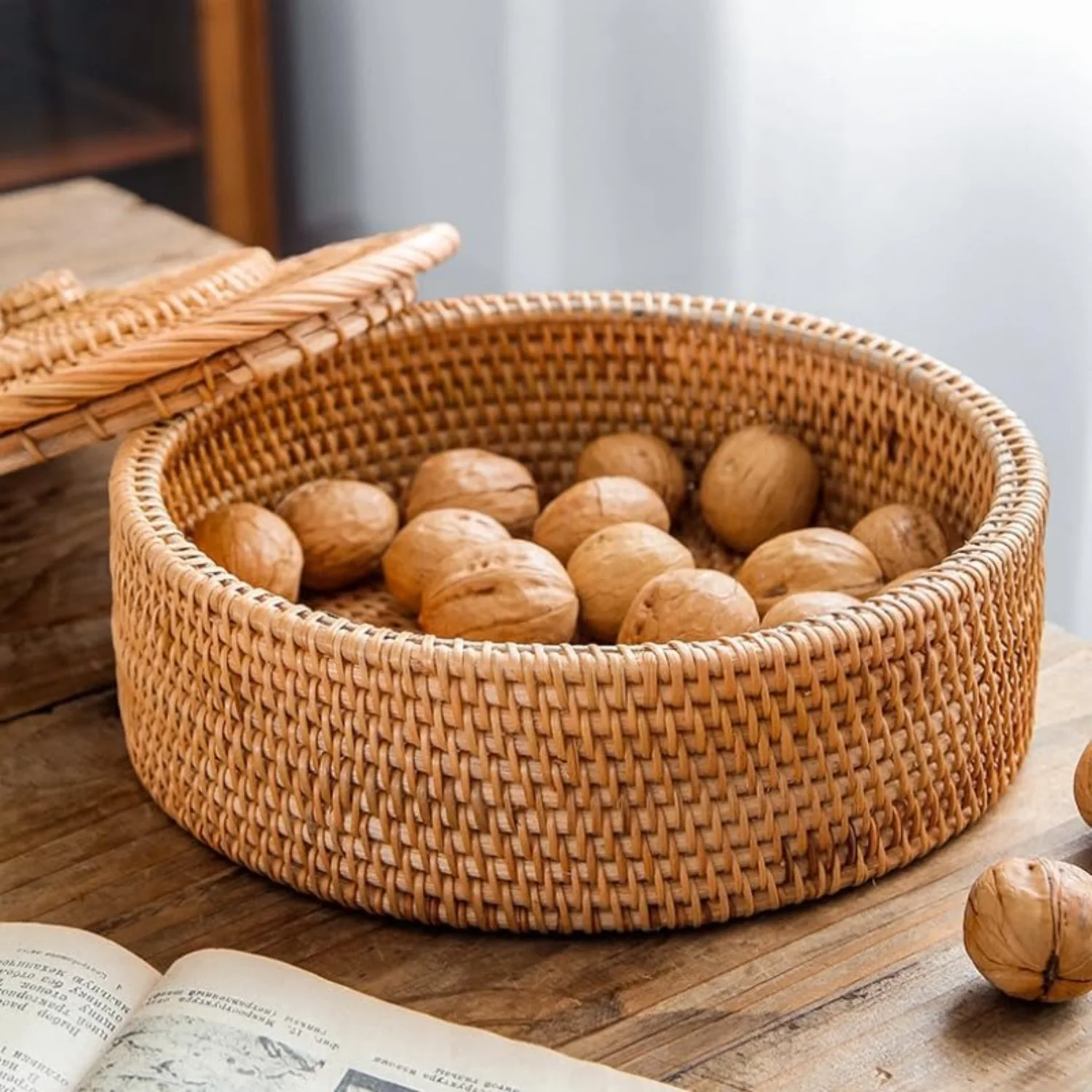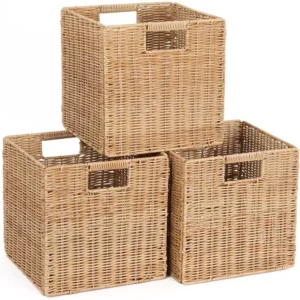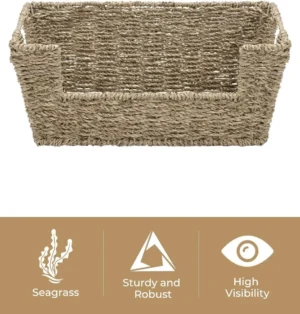Introduction: The Timeless Art of Natural Basket Weaving
Basket weaving with natural materials connects us to a craft that has spanned thousands of years across virtually every culture on earth. From intricate Egyptian burial baskets preserved in tombs to Native American gathering baskets that have survived centuries, this ancient practice represents one of humanity’s earliest and most enduring art forms.
There’s something deeply satisfying about transforming materials found in your local environment into functional, beautiful objects. As modern crafters turn increasingly toward sustainable practices, natural basket weaving offers a perfect blend of creativity, utility, and environmental consciousness.
This guide will walk you through identifying suitable natural materials, ethically sourcing them from your environment, properly preparing them for weaving, and turning them into lasting creations. Whether you’re a complete beginner or looking to expand your knowledge of traditional materials, you’ll discover new possibilities for creating with nature’s bounty.
The techniques and materials we’ll explore can create everything from simple gathering baskets to organizing laundry wicker baskets that blend seamlessly with home decor while connecting to this timeless tradition.
The Sustainable Appeal of Natural Basket Materials
Choosing natural materials for basket weaving offers numerous benefits beyond the simple joy of crafting:
- Environmental sustainability: Unlike plastic or synthetic alternatives, natural materials are biodegradable and renewable when harvested responsibly.
- Unique aesthetic qualities: Each natural material brings its own character to your work—the warm honey tones of willow, the subtle fragrance of sweetgrass, or the rich texture of bark.
- Cost-effectiveness: Many excellent basket-making materials grow abundantly and can be ethically foraged for free.
- Cultural connection: Working with traditional materials connects you to generations of craftspeople who developed these techniques across centuries.
- Therapeutic benefits: The process of gathering and preparing natural materials encourages mindfulness and deepens your connection to the natural world.
The appeal of natural materials extends beyond the crafting process. A basket made from foraged materials carries a story—of the landscape it came from, the season it was gathered in, and the hands that transformed it. This stands in stark contrast to mass-produced alternatives, as explored in our guide to natural vs synthetic wicker laundry products.
Essential Properties for Basket Weaving Materials
Understanding the physical properties that make certain plants suitable for basket weaving will help you identify potential materials in your environment and determine how best to use them.
Flexibility vs. Rigidity
Successful baskets require both flexible and rigid elements working together:
– Flexible materials form the weavers—the elements that intertwine to create the body of your basket. These need to bend without breaking.
– Rigid materials create the structural elements—the spokes, base, and rim—that give your basket its shape and strength.
Some materials, like willow, can serve both purposes depending on their thickness and how they’re prepared. Thicker rods make excellent spokes, while thinner ones become pliable weavers.
Durability Factors
Natural materials vary greatly in their longevity. Factors affecting durability include:
– Natural oils or resins that resist decay (like pine needles)
– Density of fibers (like many hardwood barks)
– Resistance to insect damage
– How thoroughly the material was dried before weaving
Workability
Some materials are simply easier to manipulate than others. Considerations include:
– How easily the material splits or sections for finer work
– Whether it maintains its shape or becomes limp when wet
– How it responds to bending around tight curves
– Tendency to break or crack during manipulation
These properties directly impact how to weave round baskets, where materials must conform to circular shapes without breaking or creating gaps.
Seasonal Considerations
The time of year you harvest dramatically affects quality:
– Woody materials like willow and many vines are best harvested during dormancy (late fall to early spring)
– Grasses often need to be gathered before or after flowering
– Barks generally separate most easily from trees in spring when sap is flowing
Understanding these fundamental properties will guide your material selection and preparation as you develop your basket weaving skills.
Vines: Nature’s Perfect Weavers
Vines represent some of the most versatile and accessible materials for basket weavers. Their natural growth pattern—long, flexible stems designed to climb and wind—makes them ideally suited for weaving.
General Properties of Vines
Most vines share characteristics that make them excellent basket materials:
– Natural flexibility and strength
– Available in various diameters for different basket elements
– Generally accessible in many environments
– Often invasive species, making harvesting beneficial to ecosystems
Key Vine Varieties
Grapevine
– Identification: Woody brown stems with shredding bark, distinctive leaf pattern
– Harvesting: Best collected in late winter when dormant
– Preparation: Can be used fresh for rustic baskets or dried and resoaked for more refined work
– Special qualities: Creates naturally rustic baskets with organic curves and interesting textures
Honeysuckle
– Identification: Hollow stems, opposite leaf arrangement, light tan to reddish bark
– Harvesting: Focus on invasive Japanese honeysuckle, not native varieties
– Preparation: Remove leaves and small branching tendrils, dry thoroughly
– Special qualities: Extremely flexible when properly prepared; creates smooth, even weaves
Kudzu
– Identification: Thick, rope-like vines with alternating leaf pattern
– Harvesting: Year-round in southern regions, focusing on mature vines
– Preparation: Remove outer bark for finer baskets or use whole for rustic designs
– Special qualities: Abundant in southern U.S.; harvesting helps control this highly invasive species
Wisteria
– Identification: Thick, woody vines with distinct leaf scars
– Harvesting: Winter months when dormant
– Preparation: Requires thorough soaking to restore flexibility after drying
– Special qualities: Strong and durable; excellent for basket frames and handles
Harvesting Techniques
When harvesting vines, follow these best practices:
– Cut vines at ground level and pull down from where they climb to get the longest possible lengths
– Avoid pulling vines directly off trees as this can damage the tree bark
– Focus on harvesting invasive species when possible
– Coil vines in the direction they naturally grow to prevent breakage
Our woven storage baskets collection showcases how these natural materials translate into functional home storage solutions, with many designs incorporating vine elements for durability and visual interest.
Grasses, Reeds and Rushes: For Flexible Weaving
Grasses, reeds, and rushes offer a different weaving experience than woody materials like vines. These materials create tighter, more uniform weaves and often feature prominently in water-resistant baskets and fine decorative pieces.
Botanical Distinctions
Though often grouped together, these materials have distinct characteristics:
- Grasses: Hollow, jointed stems with nodes; typically have flat leaves
- Reeds: Solid or spongy interiors with triangular or round stems
- Rushes: Pithy interiors, often with no visible leaves, growing in wet areas
Key Varieties
Sweetgrass
– Characteristics: Long, vanilla-scented flat blades
– Harvesting: Cut above root level, ideally after dew has dried but before midday heat
– Preparation: Dry in small bundles hung upside down, then rehydrate before weaving
– Traditional uses: Sacred to many Indigenous cultures; used for ceremonial baskets
Cattail Leaves
– Characteristics: Long flat leaves growing from water’s edge
– Harvesting: Gather in late summer when fully grown but still green
– Preparation: Dry flat, then soak briefly before using
– Best uses: Plaiting, twining, and seat weaving
Bulrush/Seagrass
– Characteristics: Round, hollow stems reaching 3-6 feet tall
– Harvesting: Cut near base when stems are fully grown
– Preparation: Dry thoroughly then soak until pliable
– Durability factors: Naturally water-resistant, making it excellent for functional baskets
Daylily Leaves
– Characteristics: Long, strap-like leaves growing from garden plants
– Harvesting: Gather outer leaves without damaging the growing center
– Preparation: Use fresh for immediate weaving or dry flat
– Accessibility: Excellent beginner material available in many home gardens
Processing and Storage
Proper processing is crucial for these materials:
– Dry materials flat to prevent curling
– Store in dark, dry locations to prevent fading
– Check stored materials periodically for insect damage
– Rehydrate by wrapping in damp towels for 30-60 minutes before weaving
Many of our rattan baskets share design elements with baskets made from these natural grasses and reeds, showcasing how these traditional materials continue to influence contemporary basket design.
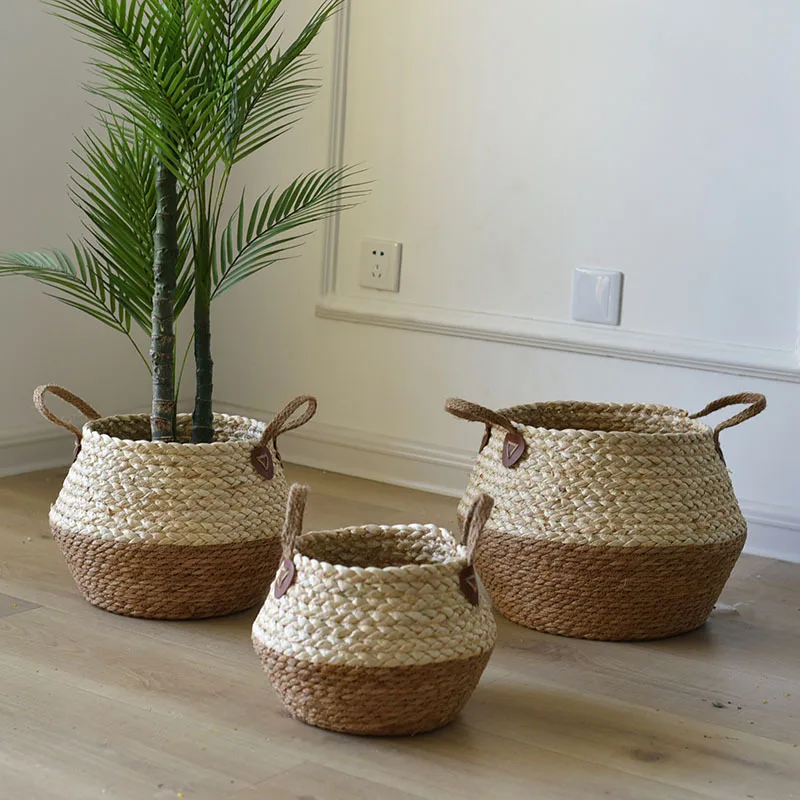
Tree Barks and Splints: For Sturdy Construction
Tree barks and splints provide some of the most durable and structurally sound basket-making materials. These materials connect modern crafters to Indigenous traditions where bark basket-making has been refined over countless generations.
Ethical Harvesting Practices
When working with bark:
– Never ring a tree (remove bark around the entire circumference)
– Harvest only from trees already cut for other purposes when possible
– If harvesting from living trees, take only small sections that can heal
– Always get permission from landowners before harvesting
Key Bark Materials
Birch Bark
– Harvesting windows: Spring through mid-summer when sap is flowing
– Waterproof properties: Natural resins make it highly water-resistant
– Traditional uses: Canoes, food storage containers, and water-carrying vessels
– Preparation: Can be used in layers or separated into thin sheets
Cedar Bark
– Preparation techniques: Separate inner and outer bark; inner bark provides flexible strips
– Splitting methods: Tear along natural grain for consistent width strips
– Cultural significance: Sacred material for many Pacific Northwest Indigenous peoples
– Versatility: Can be used for sturdy utilitarian baskets or split finely for detailed weaving
Black Ash Splints
– Processing methods: Pound logs to separate growth rings into thin, flexible splints
– Traditional importance: Foundation of Northeastern Indigenous basketry traditions
– Current challenges: Emerald ash borer threatening black ash populations
– Working properties: Creates durable, smooth baskets with even weaving
Poplar/Aspen Bark
– Accessibility: Common trees in many regions
– Workability: Relatively easy to process compared to other barks
– Characteristics: Light color, flexible when fresh, hardens when dry
– Best uses: Smaller baskets and decorative elements
Tools for Bark Harvesting
Basic tools for bark work include:
– Draw knife for initial separation
– Sharp pocket knife for detail work
– Wooden spatulas for lifting bark from trees
– Mallets for pounding ash splints
Different basket weaving styles require specific bark preparation techniques, from the fine splints used in precise checkerboard patterns to thicker strips for sturdy gathering baskets.
Specialty Materials: Unique Additions to Your Basket
Beyond the common materials, many unique plant materials can add distinctive elements to your basket weaving projects. These specialty materials often create baskets with striking textures, colors, and patterns.
Pine Needles
- Types: Longleaf pine produces the longest needles (8-18 inches), ideal for coiling
- Gathering: Collect naturally fallen needles or freshly fallen branches
- Preparation: Remove from sheaths, wash, and dry thoroughly
- Weaving technique: Primarily used for coiled baskets with raffia or waxed linen binding
Corn Husks
- Harvesting: Save husks from fresh corn or purchase dried husks
- Cleaning: Rinse fresh husks thoroughly and dry flat
- Storage: Keep dried husks in airtight containers
- Preparation: Soak briefly before weaving to restore flexibility
- Uses: Decorative baskets, dolls, and ornamental items
Garden Plant Fibers
- Yucca: Strong fibers extracted from leaves through scraping
- Iris leaves: Harvest after blooming, dry flat
- New Zealand flax: Exceptionally strong leaf fibers for twining or plaiting
Unusual Materials
- Dried seed pods: Milkweed, lotus, and poppy heads create interesting textural elements
- Philodendron sheaths: The brown casings from household philodendrons make excellent binding material
- Virginia creeper: Creates interesting red-tinged accents in autumn
Experimental Approaches
- Try combining specialty materials with traditional ones for contrast
- Use specialty materials for embellishments and accents
- Consider incorporating small amounts of unusual materials before committing to a full basket
Our specialty baskets collection showcases how unusual materials can be incorporated into functional, beautiful designs that maintain the spirit of traditional basket weaving while offering unique visual appeal.
Responsible Harvesting: Ethics and Sustainability
Ethical harvesting ensures that basket weaving remains a sustainable craft that respects natural ecosystems. Following these guidelines protects plant populations while providing quality materials.
The Rule of Thirds
When harvesting any plant material:
– Take no more than one-third of what’s available in a given area
– Leave at least one-third for wildlife and ecosystem functions
– Leave one-third to regenerate and ensure future growth
Permission Requirements
- Always get explicit permission before harvesting on private property
- Check regulations for public lands—many require permits for plant gathering
- Respect “No Trespassing” signs and closed areas
- Consider offering landowners a finished basket as thanks for harvesting access
Focus on Invasive Species
Some of the best basket materials are invasive species that harm local ecosystems:
– Japanese honeysuckle
– English ivy
– Kudzu
– Oriental bittersweet
Harvesting these plants provides excellent materials while helping restore native ecosystems.
Seasonal Timing
Proper timing minimizes damage to plants:
– Harvest woody materials during dormancy (late fall through early spring)
– Gather grasses and leaves when fully grown but before they begin to dry out
– Collect bark in spring when sap flow makes separation easier
Proper Tools
- Keep cutting tools sharp for clean cuts that heal better
- Use loppers or hand pruners rather than tearing or breaking
- Clean tools between harvesting locations to prevent spreading disease
By following these practices, you’ll ensure that basket materials remain available for future generations of weavers while protecting natural ecosystems. For those who prefer not to harvest, our woven laundry baskets offer sustainably sourced alternatives that support traditional craftsmanship.
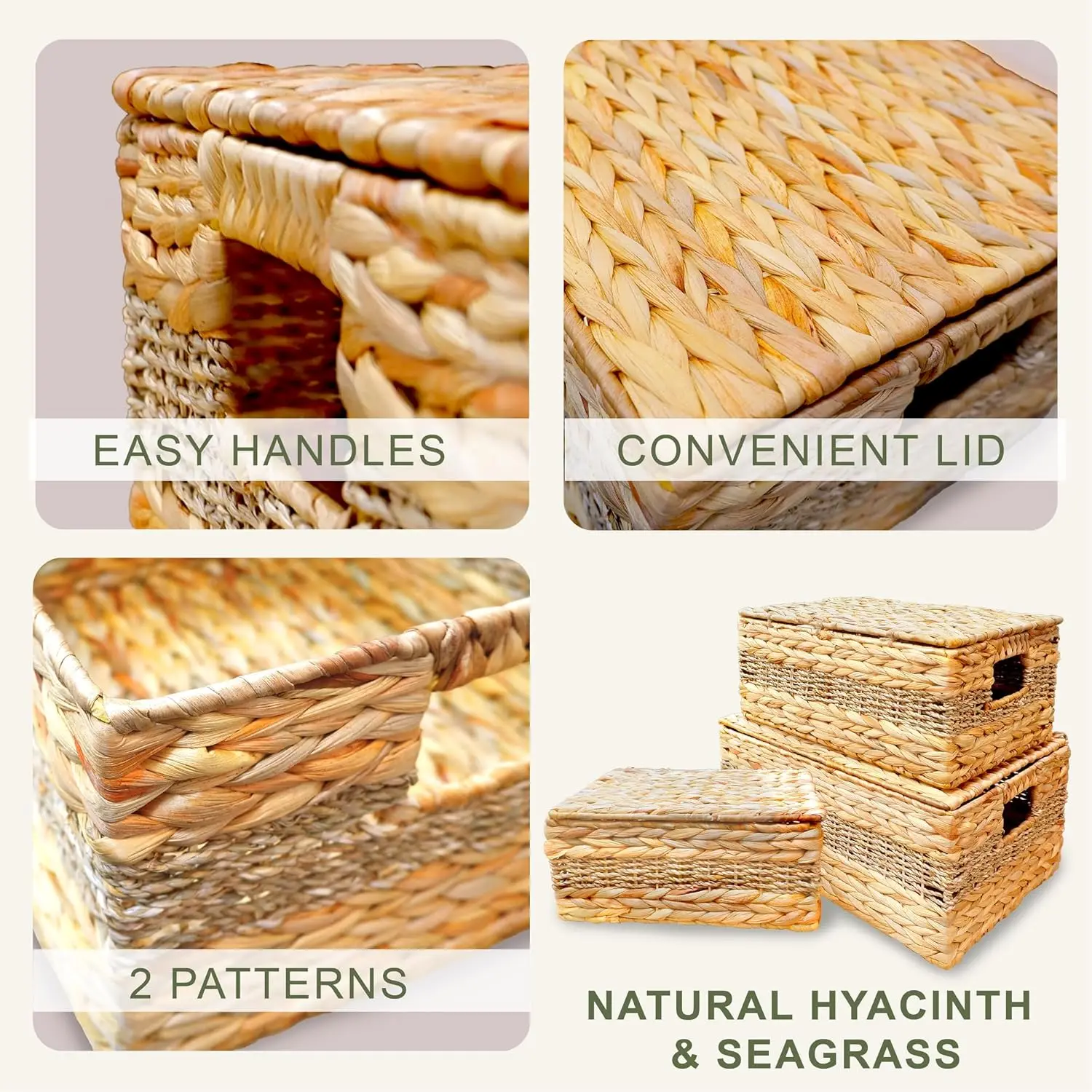
From Raw to Ready: Preparation Techniques
Transforming raw natural materials into weaving-ready elements requires specific preparation techniques. Proper preparation is often the difference between a successful basket and one that warps, cracks, or falls apart.
General Principles
Most natural materials follow this basic preparation path:
1. Clean to remove dirt, insects, and unwanted plant parts
2. Dry thoroughly to prevent mold and establish dimensional stability
3. Rehydrate when ready to weave to restore flexibility
Material-Specific Workflows
Vines and Woody Materials
– Allow to dry completely (2-4 weeks in a well-ventilated area)
– Remove leaves, side branches, and bark if desired
– Soak in room temperature water until pliable:
– Thin materials (under 1/4 inch): 1-2 hours
– Medium materials (1/4 to 1/2 inch): 2-4 hours
– Thick materials (over 1/2 inch): 4-24 hours
– Wrap in damp towels when working to maintain flexibility
Grasses and Leaves
– Dry flat to prevent curling and twisting
– Bundle similar lengths together for easier storage
– Mist with water or wrap in damp towels to rehydrate
– Work while slightly damp but not wet
Bark
– For inner bark: Scrape away outer bark while fresh
– Dry flat with weights to prevent curling
– Store flat or gently rolled
– Soak until pliable before use (typically 1-2 hours)
Pine Needles and Specialty Materials
– Remove pine needles from sheaths and sort by length
– Wash to remove sap and debris
– Dry thoroughly, then store in airtight containers
– Soak briefly (10-15 minutes) before use
Testing for Workability
Before beginning your basket, test your prepared materials:
– Bend a piece 180 degrees—it should bend without breaking
– If it cracks or splits, continue soaking
– If it feels mushy or the fibers separate easily, it’s over-soaked
Understanding these preparation methods is essential before attempting beginner basket weaving methods to ensure your materials perform as expected during the weaving process.
Where to Find Materials When You Can’t Forage
Not everyone has access to natural environments for harvesting materials, but commercial alternatives and creative sourcing can provide excellent weaving supplies.
Commercial Alternatives
Rattan Reed Varieties
– Round reed: Flexible material available in multiple diameters
– Flat reed: Creates smooth, even weaves for structured baskets
– Oval reed: Combines the strength of round with the weaving ease of flat
– Spline: Thicker material ideal for rim finishing
Commercially Prepared Willow
– Available as living willow rods or dried stakes
– Comes sorted by length and diameter
– Often pre-cleaned and ready for soaking
Processed Specialty Materials
– Split palm fronds
– Prepared pine needles
– Raffia and other binding materials
Quality Indicators
When purchasing materials, look for:
– Consistent color throughout the bundle
– Minimal black spots or discoloration
– Even diameter or width within size categories
– No visible mold or insect damage
– Flexibility when bent gently
Alternative Sources
- Garden cleanup: Save ornamental grass cuttings, daylily leaves, and iris foliage
- Tree trimming services: Ask for grape vine cuttings, willow branches, or other useful prunings
- Landscape maintenance: Connect with professionals who remove invasive species
Building Relationships
- Join basket weaving guilds or social media groups to connect with other weavers
- Arrange material swaps with other crafters in different geographic areas
- Develop relationships with property owners who have useful materials they’re happy to share
For consistently high-quality materials without the variability of foraged options, our rattan storage baskets showcase the beautiful results possible with commercially prepared natural materials.
Beginner-Friendly Natural Materials to Start With
Some materials are significantly easier to work with than others, making them ideal for beginners. Start with these forgiving options to build your skills before attempting more challenging materials.
Top 5 Beginner Materials
Reed or Commercial Rattan
– Why it’s beginner-friendly: Consistent diameter and flexibility
– Best starter project: Simple round or square basket
– Technique to master: Basic over-under weaving patternDaylily Leaves
– Why it’s beginner-friendly: Readily available in many gardens, naturally flat and flexible
– Best starter project: Small plaited basket or mat
– Technique to master: Simple plaiting (under-over pattern)Larger Diameter Willow Shoots
– Why it’s beginner-friendly: Less likely to break than thinner materials
– Best starter project: Simple frame basket
– Technique to master: Basic stake-and-strand techniqueGrapevine
– Why it’s beginner-friendly: Forgiving of irregular weaving patterns
– Best starter project: Free-form basket or wreath
– Technique to master: Random weavingPine Needles
– Why it’s beginner-friendly: Consistent material that’s easy to handle
– Best starter project: Small coiled basket with raffia binding
– Technique to master: Basic coiling
Starting with these materials allows you to focus on learning techniques without fighting difficult materials. Once you’ve mastered the basics, you can apply these skills to create effortless laundry organization wicker baskets and other practical storage solutions.
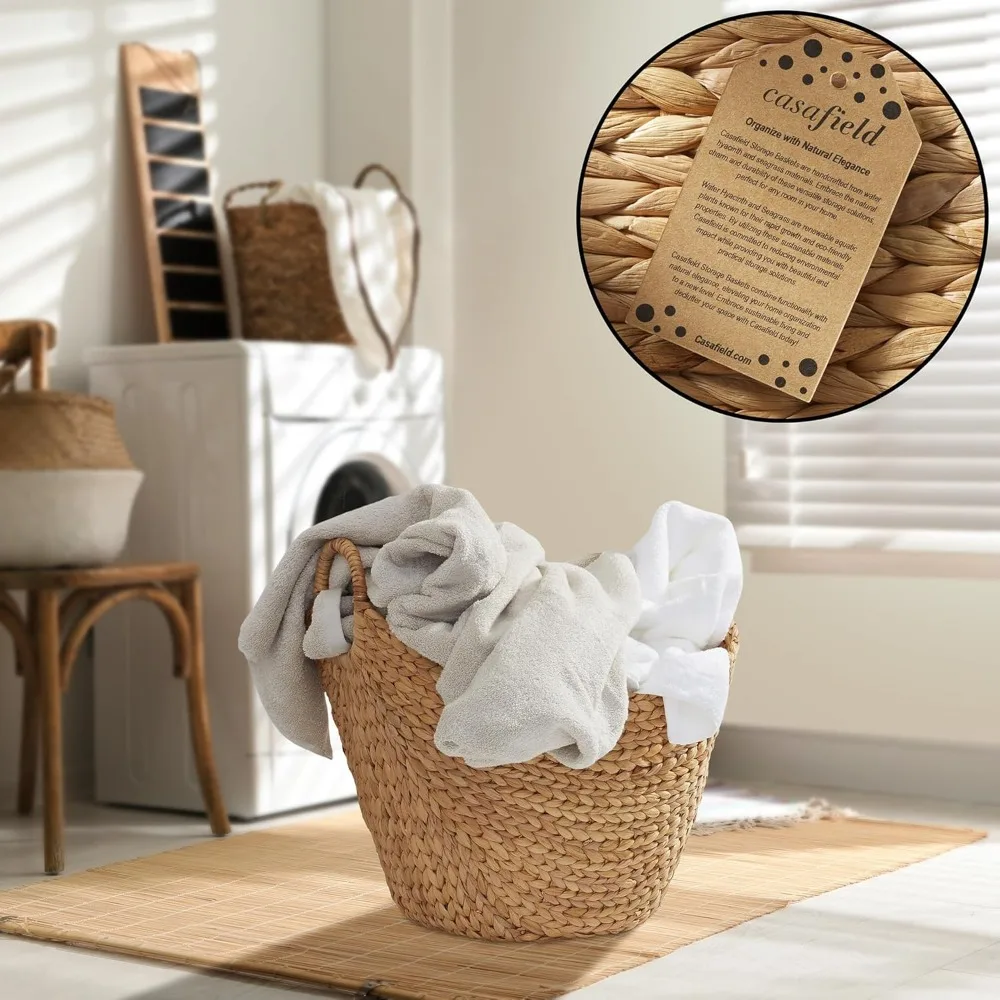
Black Wicker Baskets, Rattan Storage Baskets, Tall Wicker Baskets, Wicker Shelf Baskets, Woven Storage Baskets
5-Tier Distressed Black Wood Frame Storage Tower with Removable Wicker Baskets for Home Organization$715.80 Select options This product has multiple variants. The options may be chosen on the product pageWicker Laundry Baskets, Woven Laundry Baskets, Woven Storage Baskets
$392.02 Select options This product has multiple variants. The options may be chosen on the product pageRattan Shelf Baskets, Rattan Storage Baskets, Small Wicker Baskets, Square Wicker Baskets
Square Plastic Wicker Storage Baskets Set of 3 with Collapsible Design for Cube Storage Organization$185.47 Select options This product has multiple variants. The options may be chosen on the product pageWicker Baskets with Handles, Wicker Storage Baskets, Woven Storage Baskets
$137.92 Select options This product has multiple variants. The options may be chosen on the product pageLarge Wicker Laundry Baskets, Tall Wicker Baskets, Woven Laundry Hampers, Woven Storage Baskets
$130.54 Select options This product has multiple variants. The options may be chosen on the product pageWoven Laundry Baskets, Woven Laundry Washing Baskets
Price range: $136.76 through $581.37 Select options This product has multiple variants. The options may be chosen on the product page
Beyond the Basics: Advanced Combinations and Techniques
As your skills develop, experiment with combining different materials in a single basket to leverage the unique properties of each and create distinctive designs.
Material Combinations
Strategic material pairing enhances both structure and aesthetics:
– Use rigid materials (reed, thick willow) for spokes and frame elements
– Apply more flexible materials (thin vines, grasses) for intricate weaving patterns
– Incorporate specialty materials as decorative accents or borders
Natural Color Variations
Many basket weavers create patterns using only the natural colors of different materials:
– Contrast the pale cream of inner bark with the rich brown of outer bark
– Pair golden wheat straw with deep green dyed reed
– Layer red-toned willow with pale cattail leaves for subtle striping effects
Advanced Processing Techniques
Experiment with these methods to achieve specialized results:
– Scraping wood vines to reveal different colors underneath
– Splitting round materials to create flat, ribbon-like weavers
– Soaking certain materials in wood ash solution to enhance flexibility
Natural Dyeing Possibilities
Create colored materials using plant-based dyes:
– Walnut hulls for deep browns
– Goldenrod flowers for yellows
– Blackberry for purples and blues
– Onion skins for oranges and yellows
These advanced techniques can help you develop your signature style while maintaining your commitment to natural materials. For inspiration on combining techniques and materials, explore our intermediate basket weaving projects guide.
Frequently Asked Questions About Natural Basket Materials
How long will my natural material basket last?
With proper care, natural baskets can last for decades or even generations. Durability depends on:
– The specific materials used (bark and reed tend to outlast grasses)
– How the basket is used (display items last longer than heavily used utility baskets)
– Storage conditions (avoid excessive humidity and direct sunlight)
– Protective finishes applied (some weavers apply natural oils or waxes)
How do I prevent mold on my basket materials?
Mold typically results from insufficient drying or improper storage:
– Ensure materials are completely dry before storage
– Store in well-ventilated areas with low humidity
– Consider adding silica packets to storage containers
– For visible mold, brush off, then wipe with a cloth dampened with equal parts white vinegar and water
Can I use green (fresh) materials, or must they be dried?
Some materials can be used fresh, but most benefit from drying:
– Fresh materials will shrink as they dry, potentially causing your basket to warp
– Some materials (like willow) are actually more flexible after being dried and resoaked
– Fresh grasses and leaves are sometimes used for immediate projects but may change shape as they dry
– Fresh bark is easier to work with but must be properly secured as it dries to prevent warping
How do I know when my soaked materials are ready to use?
Properly soaked materials should:
– Bend easily without breaking or cracking
– Not feel brittle or stiff when flexed
– Not be so saturated that they’re mushy or falling apart
– Return slowly to shape when bent (but not snap back rigidly)
For more practical applications of basket weaving skills, check out our guide to DIY laundry organization wicker baskets with tips specifically for home organization projects.
Caring for Your Natural Material Baskets
Proper care extends the life of your handcrafted baskets and preserves the beauty of the natural materials.
Storage Best Practices
- Store baskets in dry locations away from direct sunlight
- Avoid areas with extreme temperature fluctuations
- Never store heavy items inside lightweight baskets
- Stuff larger baskets with acid-free tissue to maintain shape
Cleaning Methods
- Regular maintenance: Dust with a soft brush or vacuum with brush attachment
- Dry cleaning: Wipe with a barely damp cloth and dry immediately
- Deep cleaning (when necessary): Use minimal water with mild soap, rinse carefully, and dry thoroughly
- Avoid full immersion in water unless the basket was specifically designed for it
Maintenance Routines
- Check periodically for signs of insect activity
- Rotate displayed baskets occasionally to prevent uneven fading
- Apply small amounts of paste wax or lemon oil to very dry baskets (test in an inconspicuous spot first)
- Keep baskets away from heat sources that can cause brittleness
Simple Repair Techniques
- Broken elements: Soak replacement material to match flexibility, then weave into the damaged area
- Loose weaving: Carefully mist with water to swell fibers and tighten weave
- Frayed edges: Trim carefully and secure with matching material
For more ideas on displaying and using your finished baskets, explore our wicker laundry basket storage ideas with creative solutions for incorporating baskets into your home decor.
By following the techniques in this guide, you’ll be well-prepared to create beautiful, functional baskets from the abundance of materials that nature provides. Whether you forage your own materials or purchase them commercially, working with these natural fibers connects you to a rich tradition of craftsmanship while creating unique, sustainable storage solutions.

